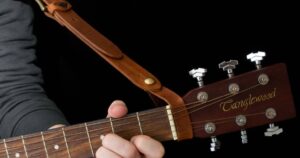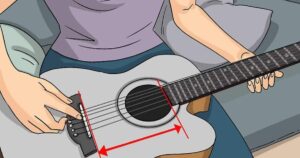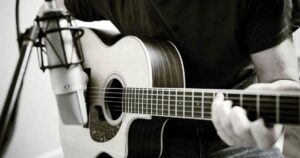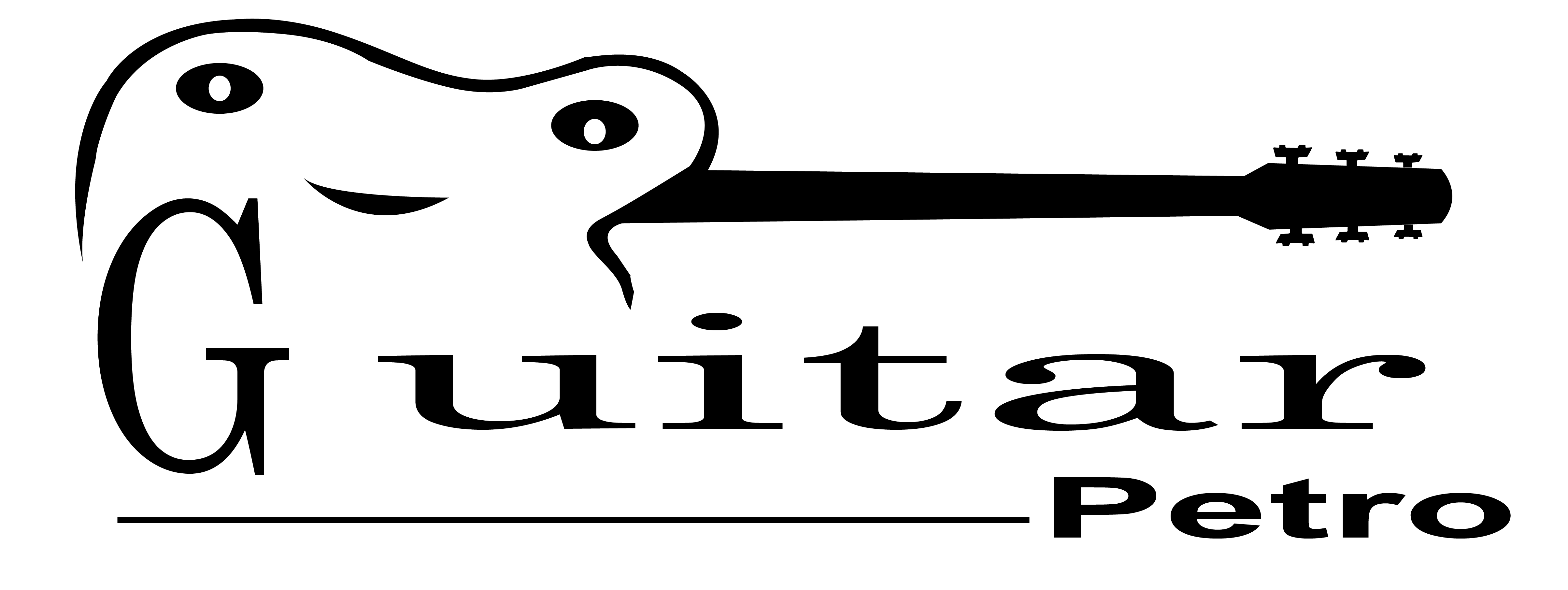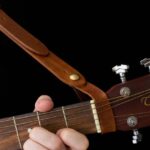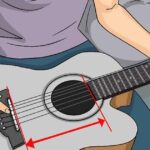Learning How to Play 7 Nation Army on Acoustic Guitar involves acquiring the skills to play the iconic riff from the song Seven Nation Army by The White Stripes on an acoustic guitar. This popular riff is known for its simplicity and distinctive sound.
Picture yourself strumming your acoustic guitar, creating the catchy, foot-tapping melody of Seven Nation Army. This iconic riff is a must-learn for any aspiring guitarist, offering an exciting entry point into the world of guitar playing.
Playing Seven Nation Army on an acoustic guitar is a fantastic way to build your fingerpicking and fretting skills. With its memorable melody, it’s a crowd-pleaser at gatherings, making it a fun and engaging addition to your repertoire.
Getting Started
Before we dive into learning the song, it’s essential to make sure you’re well-prepared. Here are some initial steps you should take:
Tune Your Guitar
Tuning your guitar is a crucial step to ensure it sounds just right. 7 Nation Army is typically played in the key of E, so you’ll want to make sure your strings are tuned to E A D G B E. You can use a guitar tuner or an online tuning tool to help you with this.
Familiarize Yourself with the Song
Before you start playing, listen to the song multiple times to get a feel for its rhythm and melody. Understanding the song’s structure and how the guitar part fits in will make it easier to learn.
Practice Basic Chords
7 Nation Army uses simple power chords, so if you’re a beginner, practice some basic power chord shapes. These chords are often used in rock and punk music and form the foundation of the song.
The Main Riff
The iconic riff of 7 Nation Army is what sets this song apart and makes it instantly recognizable. The riff is played using a combination of power chords and open strings. Let’s break it down step by step:
The Main Chord
The primary chord in the riff is the B power chord, which is played like this:
- Place your index finger on the 2nd fret of the A string.
- Place your ring finger on the 4th fret of the D and G strings.
Strumming the Chord
- Strum only the A, D, and G strings.
- Let the high E string (the thinnest string) remain open and don’t press it down.
The Rhythm
The key to capturing the essence of “7 Nation Army” lies in the rhythm. The riff is played with a distinctive rhythm that goes like this:
- Downstroke: Start with a downstroke on the B power chord.
- Upstroke: Follow it with an upstroke on the same chord.
- Pause: Then, pause briefly before repeating the down-up motion.
This rhythm creates the song’s infectious groove. Practice it slowly until you get comfortable with the timing.
The Open Strings
The open strings are crucial to the riff’s sound. While playing the B power chord, be sure to keep the high E string open. The open string adds a unique depth to the sound and enhances the overall texture of the riff.
Repeating the Riff
The beauty of the 7 Nation Army lies in its simplicity. The riff is repeated throughout most of the song. To play the full riff, follow these steps:
- Start with the B power chord.
- Repeat the down-up motion with the right rhythm.
- Maintain the open high E string.
- Continue playing this pattern for the duration of the riff.
Transitioning Between Chords

In addition to the main riff, there are a couple of chord changes in the song that you’ll need to master. These chords add variation and dynamics to the music. Here’s how to transition between them:
1. The Transition to E Power Chord
During the chorus of 7 Nation Army, you’ll need to switch from the B power chord to the E power chord. Here’s how to do it:
- Lift your fingers from the B power chord.
- Place your index finger on the 2nd fret of the A string.
- Place your ring finger on the 4th fret of the D and G strings.
- Strum only the A, D, and G strings, just like you did with the B power chord.
Practice the transition between these two chords until it feels smooth and natural.
The Transition to A Power Chord
Another chord change in the song is from the B power chord to the A power chord, which is used in the bridge. Here’s how to make this transition:
- Lift your fingers from the B power chord.
- Place your index finger on the 2nd fret of the D string.
- Place your ring finger on the 4th fret of the G string.
- Strum only the D and G strings.
As with the previous transition, practice moving between the B and A power chords until you can do it effortlessly.
Putting It All Together
Now that you’ve learned the main riff and the chord transitions, it’s time to put everything together and play along with the song. Follow these steps:
Start with the Main Riff
Begin by playing the iconic B power chord riff, maintaining the unique rhythm and keeping the high E string open. This riff is the foundation of the song.
Chord Transitions
When the song calls for a chord change, smoothly transition to the appropriate chord. Remember to follow the finger placements and strum only the specified strings.
Practice with the Song
Play along with the song as you listen to it. Try to match your timing with the original recording. This may take some time and practice, so be patient with yourself.
Master the Open String Sound
The sound of the open high E string is crucial for nailing the song’s signature sound. Make sure you’re letting it ring out during the B power chord sections.
Tips for Better Playing

To improve your performance and make playing “7 Nation Army” on your acoustic guitar even more enjoyable, consider the following tips:
Use a Capo
If you want to match the original recording’s pitch, you can use a capo. Place the capo on the 7th fret and play the same chord shapes as before. This will make the song easier to sing along with and provide a unique sound.
Experiment with Dynamics
While the song has a consistent riff, you can add dynamics to make it more interesting. Try varying the intensity of your strumming and the volume at different parts of the song.
Play Along with the Drum Beat
To truly capture the essence of “7 Nation Army,” try playing along with a drumbeat. The song’s rhythm section is powerful and provides an excellent backdrop for your guitar playing.
Record Yourself
Recording your practice sessions can be incredibly beneficial. It allows you to analyze your performance and track your progress. You can also share your recordings with friends or on social media to get feedback and encouragement.
Common Challenges and Solutions
Learning any song, especially one with a distinctive riff like “7 Nation Army,” can present some challenges. Here are a few common issues you might encounter and how to overcome them:
Rhythm Difficulties
If you’re struggling with the rhythm of the main riff, practice it slowly with a metronome. Gradually increase the tempo as you become more comfortable. Consistent practice is the key to mastering the rhythm.
Finger Placement
Getting your fingers in the right position for the power chords can be tricky, especially if you’re a beginner. Take your time to practice the transitions between chords until they become second nature.
Maintaining Open String Sound
Remembering to keep the high E string open while playing the B power chord can be a challenge. Focus on this aspect during your practice and pay attention to your strumming hand’s movement.
Strumming Control
Achieving the right strumming technique is crucial for the song’s feel. If your strumming is inconsistent or too heavy, practice strumming exercises to improve your control.
FAQ’s
Is 7 Nation Army a beginner-friendly song?
Yes, it’s perfect for beginners! The main riff is easy to learn and sounds great on an acoustic guitar.
Do I need any special equipment to play it on acoustic guitar?
No special equipment is needed. Just grab your acoustic guitar, and you’re good to go.
Can I find online tutorials to help me learn 7 Nation Army on acoustic guitar?
Absolutely! There are plenty of free online tutorials and tabs available to guide you through the process.
Conclusion
Learning how to play 7 Nation Army on an acoustic guitar is a fantastic journey for beginners and experienced guitarists alike. This iconic riff is simple, yet it packs a powerful, recognizable punch. It’s an excellent starting point for anyone looking to develop their fingerpicking and fretting skills. Plus, the joy of strumming this tune is unmatched, making it an engaging addition to your repertoire.
With countless online tutorials and tabs available, you have a wealth of resources at your fingertips to guide you through the learning process. Remember, practice and patience are your best friends in mastering this riff. So, grab your acoustic guitar, embrace the music, and enjoy the satisfaction of playing 7 Nation Army on your own terms. It’s a rewarding experience that connects you with the essence of rock and roll.


